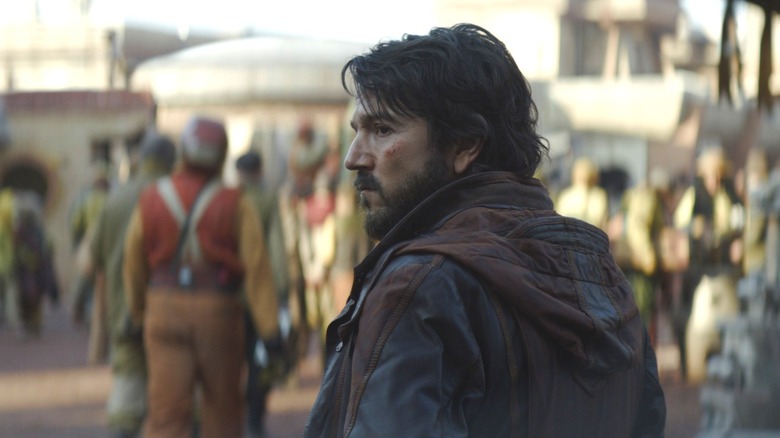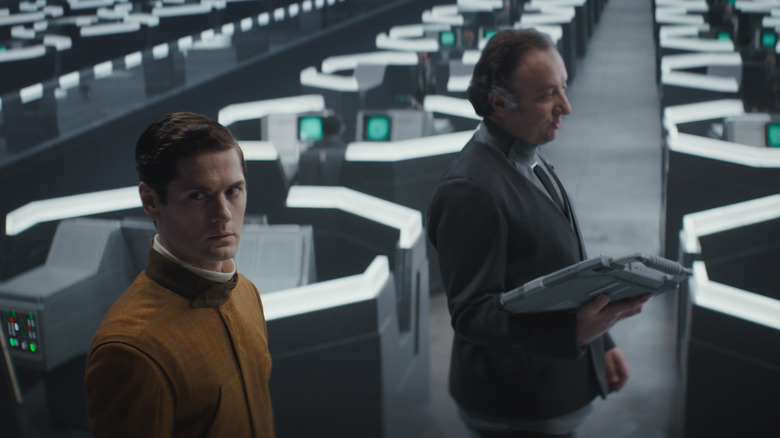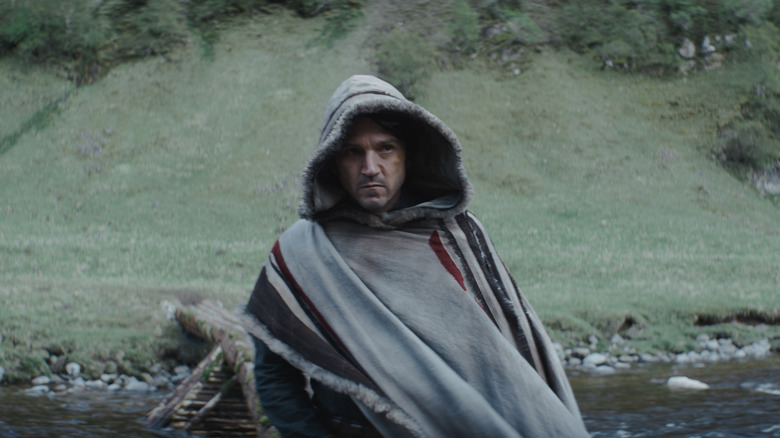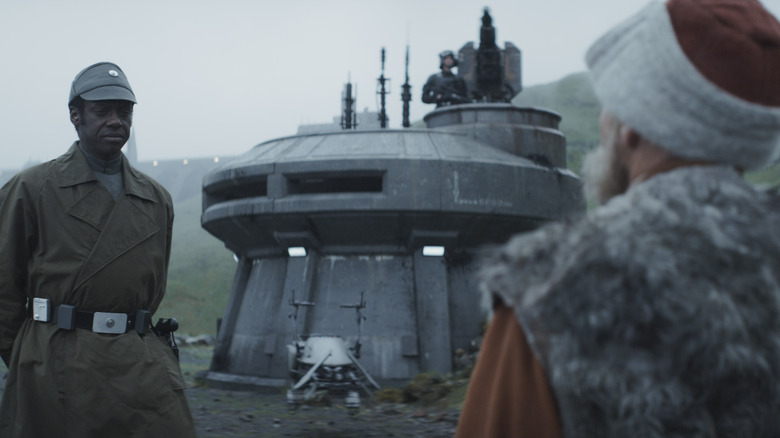Andor Production Designer And Costume Designer On Bringing New Things To The Star Wars Universe [Exclusive Interview]
How does one go about creating one of the best, most intense, and formally daring stories in all of "Star Wars?" Well, you go out, get the most talented artists, and put them in charge of various levels of production. Sounds simple enough, right? Having a filmmaker of the caliber of Tony Gilroy spearhead "Andor" already put this prequel series on solid ground, but his decision to collaborate with the best in the business has clearly been paying dividends throughout the first several episodes of the season. But while Gilroy's vision has received all its deserved praise, we'd be remiss not to look deeper and show some appreciation for the below-the-line contributions that have played invaluable roles in turning "Andor" into the acclaimed addition to the franchise that it is (you can read /Film's review here).
I recently had the opportunity to speak to two of the chief architects behind "Andor," production designer Luke Hull and costume designer Michael Wilkinson. With eclectic and impressive dossiers of past projects, these experts in their respective fields provided all sorts of eye-opening insights into the level of care and attention that went into the making of such a thrilling series. Throughout the course of our discussion, the pair talked about the memorable production design of the dystopian Imperial Bureau of Standards, the unique challenges of coloring within the lines of familiar "Star Wars" aesthetics, and the wide-ranging number of industry figures whose work influenced their decisions, from Jacques Tati to Zack Snyder.
'The Star Wars version of the office cubicle'
This interview has been lightly edited for clarity and brevity.
I am obsessed with the visuals of the Imperial Bureau of Standards in episode 8. The visual of all these desk-jockeys chained to these little cubicles, endlessly going on the distance, is just so evocative. What was the approach and influences behind crafting this location?
Hull: Actually, the inspiration was from a Jacques Tati film called "Playtime." Films like "Brazil" and things like that, where you have this endless [drudgery] of desks, people doing various plugged-in, mindless bureaucratic tasks, so it was our version of that which we were trying to channel. And also that mid-level kind of bureaucracy, as well, and this idea that there could be rooms and rooms of these hives somewhere. I mean, it's not an original idea, at all. It was the "Star Wars" version of the office cubicle, essentially, was the idea. Everything else sprung from that ... that's where it came from.
You came to this after doing "Chernobyl." Do you find it more difficult to base production design on something historical, something you can look up photos of, or creating something that's basically just from your own imagination in "Star Wars?"
Hull: It's so interesting ... I actually don't. I prefer to have no basis to start from [laughs]. So actually, playing in what felt like someone else's sand box, I suppose, for "Star Wars," more than anything, was intimidating. But once you get the competence and everyone at Lucasfilm excited to do it your way or your approach, that was a bit more freeing. I mean, "Chernobyl" was just a completely different beast. In terms of research, it's not that much different, I suppose, because there's so much canon and history and law to start with that you could spend a lifetime even just researching it like you would any period show or event.
But I guess I'm a different person, I just like to do something different each time. And this couldn't have been more different to, say, "Chernobyl." I mean, the job between "Chernobyl" and this was actually the "Game of Thrones" pilot that will never be seen, and then that was also a very different flavor. So I think I approach it with the same mindset in terms of how you approach any project, but I've actually found working on "Star Wars" increasingly more freeing and fun and endless opportunities and still keep trying to keep it in that language of "Star Wars," if that makes sense.
'Luke and I just really did deep-dive in such depth of all of the different planets that we had to go to'
I'll throw that question back to you, Michael. I'm assuming it's the exact opposite with you?
Wilkinson: I think I enjoy both approaches, but I think I'm also quite used to this idea of taking a franchise and IP characters that have been beloved for a long time and finding my own angle and my own approach to things. So when you're doing superheroes, you are often dealing with characters that have existed and been represented for decades. And so I also perhaps have a little bit of a blank canvas fear of like, "Wow, if it could be anything." That can be a little stultifying sometimes. So actually, having this wonderful language of costumes that has been established for 40 years in the "Star Wars" worlds, it's been the vision of so many costume designers over those decades offered their version of this world. And here's my opportunity to look at my scripts, the story that we need to tell, and work out how to do that. I love the design challenge of that. So I found the process overwhelming, but super cool [laughs].
Since you mentioned superheroes, I have to ask: Did working with Zack Snyder prepare you in any way for a production on the scale of "Andor?"
Wilkinson: Absolutely, I think what helped, the sense of world-building when you are so deep-diving into creating new worlds with the production designer, with your directors, with your lighting directors, it's a very collaborative approach that I definitely had a great education on with all of Zack's movies. But Luke and I just really did deep-dive in such depth of all of the different planets that we had to go to, I think there was seven or eight of them in season 1. And so, thinking about every aspect of those planets and environments, and how the climate and the raw materials might influence the look of the place, the culture of the people, their beliefs, is it urban, is it tribal? What technologies do they have, and how does all of that affect the look of their environments and their clothing? That's something that — I definitely learned that approach on my previous films and to go even deeper with Luke was really exciting and a great process.
'Within the Imperial uniforms, there's storytelling there'
A lot of the aesthetics of "Andor" are built-in as a result of all these decades of franchise history. So, for example, any scene featuring the Empire, you're kind of locked into tones of white and gray and black. Did you find that creatively restricting or was it maybe the exact opposite?
Hull: [Thoughtful pause] No, no, not creatively restricted. I think, yeah, there's certain things you can't get away from, like tentpole language, I suppose, of "Star Wars," which is fine. I think it's how we fit that into our shows. Like, how does the Senate work in our show? It's different, I don't know if anyone's noticed, but [laughs]. And how far do we take it? I mean, Coruscant's a massive planet, I'm sure there's lots of different areas and zones, and so that's sort of the approach that I take. I actually think it works really well to have this kind of stark contrast between the Empire being more monochromatic than, say, a much more kind of complex culture, a human culture like Ferrix.
It's just storytelling really, actually. So, no, I don't think it's restricted from my point of view. I actually found it quite nice to invert it in places like the [Imperial Security Bureau] conference room to actually make that stockingly lab-white, that crispness, that you can't hide in that room. It's the CIA. Every meeting in that set is an interrogation [laughs]. So no, I don't think it's restrictive, and like Michael said, we talk constantly. Not enough recently, actually [laughs], but yeah, just it's very enjoyable to work with Michael, who thinks about things equally on a complex level. How do you feel about that, Michael? I think it doesn't affect me that way.
Wilkinson: Yeah, I feel like, I actually appreciated things like the established costumes of the Empire. I think really helps. You need elements like that to ground us firmly in the known "Star Wars" world, so that you can then choose the moments to leap off and try new directions. So without that, it might not feel too much like "Star Wars" to an audience, but grounding it with those elements allows us to be a little bit more adventurous in other areas.
But even within that, within the Imperial uniforms, there's storytelling there. As far as deep-diving into the ISB, we haven't really seen that in detail before. The different ranks, how the power structure works there. We've seen the green army uniform in other films before, but we haven't seen all the different ranks and the dress uniform that we get to see in Aldhani when it has the formal moment meeting the Aldhani nomads. There's all sorts of areas where you can, even things as rigid as uniforms, you can help shed light into the story and to the characters.
Michael, I couldn't let you go without asking one more question. Since I just finished reading "The Three-Body Problem" just a few days ago, can you confirm whether you're working on that and how that's going for you?
Wilkinson: Oh my gosh [laughs]. I have just finished the first season of "The Three-Body Problem." It was a huge challenge. Since you've read the book, you can probably imagine what a challenge it is to turn that into a piece of a long format series. It's full of really interesting, complex ideas, both philosophical and scientific. But I feel like the filmmaking team has really succeeded in bringing lots of humanity, and it's now a very engaging and thought-provoking story. So I look forward to seeing that when it comes out in a year or so.
New episodes of "Andor" hit Disney+ on Wednesdays.



